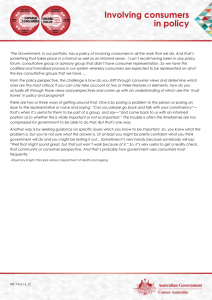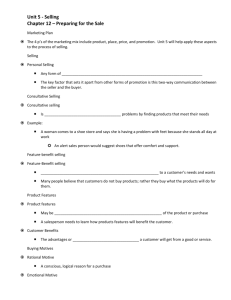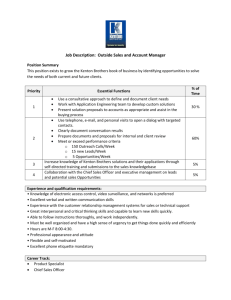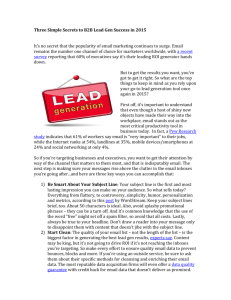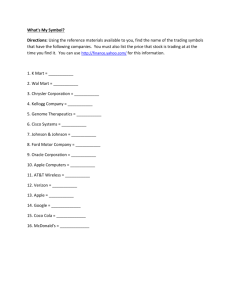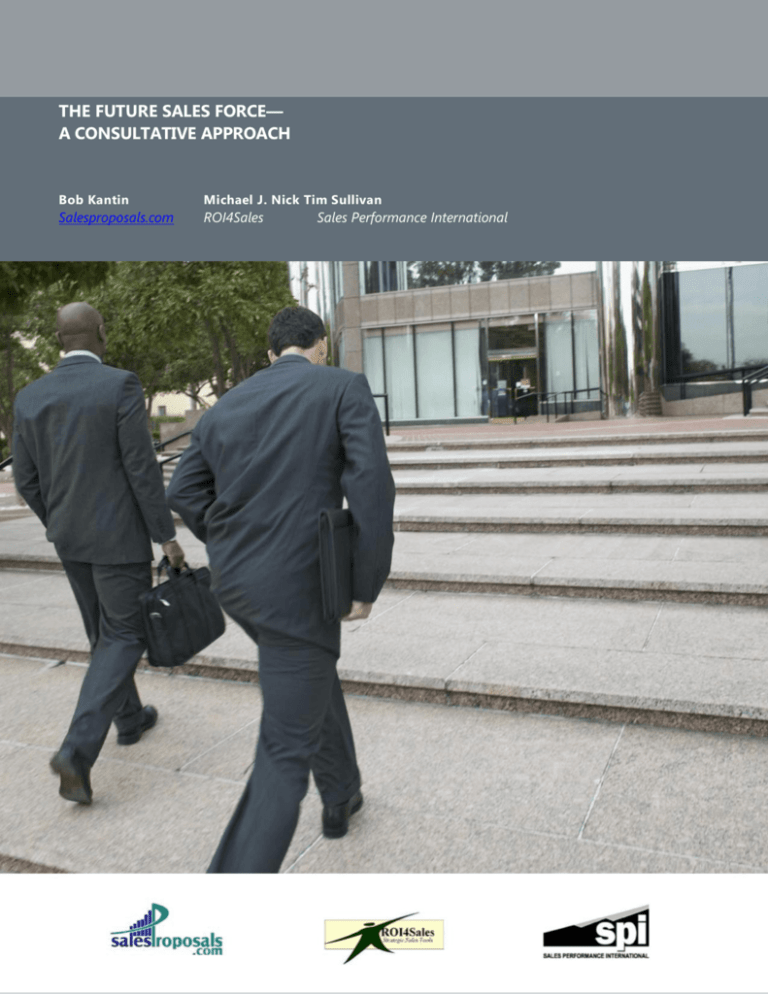
THE FUTURE SALES FORCE—
A CONSULTATIVE APPROACH
Bob Kantin
Michael J. Nick Tim Sullivan
Salesproposals.com
ROI4Sales
Sales Performance International
THE FUTURE SALES FORCE—
A CONSULTATIVE APPROACH
Bob Kantin
Salesproposals.com
Michael J. Nick
ROI4Sales
Tim Sullivan
Sales Performance International
IN THE LAST FEW YEARS SOME ORGANIZATIONS HAVE FOUND THAT THEIR SALES
PROCESSES HAVE BECOME MORE CHALLENGING WHILE THE PERFORMANCE OF SOME OF
THEIR SALES PROFESSIONALS WHO WERE PAST STARS HAS DETERIORATED. SELLING
COMPLEX PRODUCTS AND SERVICES, VERSUS SELLING COMMODITIES, HAS ALWAYS BEEN
MORE DIFFICULT AND SALES PROFESSIONALS MUST HAVE DIFFERENT SKILL SETS, AS
ILLUSTRATED BELOW.
COMMODITY-TRANSACTION SALE
COMPLEX SALE
Simple product or service—perceived as a commodity
by the buyer
Complicated product or service
One or two calls—perhaps telemarketing
One or two apparent decision makers
Low risk
Relationships less important—buyer views the sales
professional as vendor
Multiple consultative calls, demonstrations, and
presentations—perhaps technical sales support
Multiple decision makers—executive committee or
board-level decision
High risk
Technique selling
Relationships very important—buyer may view the
sales professional as a business consultant
Price quote
Value-based selling
Price and availability more important
Proactive sales proposal or response to a
Request for Proposal (RFP)
Return on investment (ROI) very important or required
THE FUTURE SALES FORCE—A CONSULTATIVE APPROACH
Other factors in most complex sales also have
contributed to process and performance problems:
FOLLOWING A CONSULTATIVE
SALES PROCESS
The economy—companies don’t have the funds to buy
Changes in the buying process since the late 90’s—
companies no longer buy products and services without
first completing in-depth analyses
Required value proposition—sellers must prove that
their proposed products or services make or save
money
Most companies recognize that the world and their
buyers’ buying processes probably have changed forever.
But, some companies haven’t recognized the need to
make changes in their sales forces. They wonder if their
sales professionals can’t sell like he did in the past.
Perhaps many sales professionals don’t have the skills or
tools needed. Here are some questions a company might
ask to assess their sales situation.
Do our sales professionals . . .
Follow a consultative sales process designed specifically
for our unique products or services?
Have the ability to calculate an ROI for our specific
products or services that is accurate, unbiased, and
plausible?
Write customer-centric sales proposals that help buyers
make informed buying decisions?
If the company uses a contact management or customer
relationship management (CRM) system, it needs to ask
one additional key question. Does our CRM or contact
management system tie our consultative sales, ROI
analysis, and proposal production processes together?
Sales professionals fall into two classifications: eagles and
journey people. The majority of sales organizations are
composed of journeypeople who rely on their knowledge
of the company and its offerings in sales calls. Journey
people are most comfortable talking about their
company’s capabilities. They make lots of statements
about their products and services, in hopes that
something will resonate with the buyer. In general,
journeypeople see their job as a facilitator of transactions
between their company and its customers.
While representing less than 20 percent of most sales
teams, eagles produce the bulk of sales revenues—in
some cases, more than 80 percent. What makes eagles
so much more effective than journeypeople? Eagles
focus on the customer and their business issues and
have intelligent conversations about their customers’
challenges. In general, eagles see their job as capturing
pertinent customer information, diagnosing customer
issues, and then prescribing the most suitable solutions.
Customers view journeypeople as sales agents or vendors
only. However, they view eagles as consultants, because
they provide value in every meeting. Customers will buy
from journeypeople if required, but in general, they buy a
lot more from eagles—as much as four times more and
they also like buying from them.
The good news is that journeypeople can be taught to
behave more like eagles. The methods and techniques
used by eagle sales professionals can be captured in a
repeatable process. But, this process must be tailored
to the unique products and services of each selling
organization. Once established, the process can be
taught to everyone in the sales team.
THE FUTURE SALES FORCE—A CONSULTATIVE APPROACH
With a consistent sales process, journeypeople will know
how to engage in consultative selling behavior on every
call. They can have conversations designed to gather the
information needed to diagnose the specific challenges
of that customer. Then they can prescribe the most
appropriate product or service to address that challenge
and develop a supporting value proposition.
Most importantly, by following a consultative sales
process, sales professionals will capture information that
can be used to differentiate themselves from competitive
alternatives. In other words, the sales professional can gain
a competitive advantage by h o w they sell, and not just by
w h a t they sell. Specifically, eagle sales professionals excel
in justifying the value of their proposed solutions and how
they communicate that potential value to customers in
their sales proposals. They can do this because they have
diagnostic conversations with customers focused on the
customer’s issues and challenges. They also can have sales
tools and systems that integrate with and reinforce their
company’s unique sales process.
SELF ASSESSMENT: CONSULTATIVE
SALES PROCESS
Take a moment and assess your current situation as it
pertains to your sales process. The horizontal axis
indicates your level of customization for your current sales
tools. Did you hire a consultant to customize the training?
Did you simply attend a public seminar? Do you have an
ongoing program for training? The vertical axis indicates
the commitment of your management team to the use
and promotion of a sales process. Commitment includes
financing, attending training, incorporating the vernacular
into reports, etc. For example, if you currently use a hybrid
of methodologies, no custom training, and no
commitment from executive management, then you would
likely fall into the box labeled “1”. Please take a moment
and put an “X” in the box you feel best describes your
current situation.
Consultative Sales Methodology
High
With a consultative sales process, a sales team will
produce better ROI analyses for its customers, and
improved sales proposals that are customer-focused. A
consultative sales process is an essential first step in
turning your sales team into a competitive advantage.
3
5
Management
commitment with no
customization
Total management
support with complete
customization
1
No management
support and no
customization
Low
3
Some customization
with no management
support
High
Customization Level
Note: A score of 2 or 4 will fall on the line between quadrants.
Score analysis
1. Your organization lacks adequate sales process
customization and management commitment to really
be a successful consultative selling candidate.
THE FUTURE SALES FORCE—A CONSULTATIVE APPROACH
2. Although you are making strides in either commitment
or customization, there is still a major lack of both to
make much of an impact on the sales process.
3. You have gained momentum and have an opportunity
to succeed. Pull it all together and identify what you
need to create a complete customized sales process, or
additional management support and commitment.
4. 3 and 4 are very similar in that you must be very careful
where you put your “X.” If the X falls on the line
between highly custom and half way up the
management commitment line, you are on your way to
a very successful career. If your 4 is halfway across the
customization line, and on the line between low and
high, you still have more to do to be successful. Be
aware of silo projects when this occurs.
is inconsistent, irrelevant, or not pertinent. A sales
professional should have questions and data that will
enhance the conversation, not delay the opportunity.
These questions should be an integral component of a
consultative sales process and some of the buyer’s
answers to critical, key performance questions belong
in a customer-focused sales proposal.
2. The longer a sale takes, the less chance you have
of winning the opportunity—Sales process research
consistently shows that the longer a sale takes to close,
the greater the risk of losing the sale to a competitor,
or worse, to no decision. Using value justification and
ROI helps reduce time to revenue because this financial
information defines the buyer’s cost of delaying the
decision or maintaining the status quo. A sales
professional should be prepared to use these buyer
costs in the consultative sales process and in the sales
proposals.
5. Excellent job! You are on you way to a very successful
sales career. Remember that this is only one
component to success, however.
USING AN ROI ANALYSIS SYSTEM
ROI and Value Justification are becoming “must-have”
components in the selling equation. The ROI Insider on
www.searchcio.com states that “more than 80 percent of
IT buyers now rely on vendors to help them quantify the
value proposition of solutions.” In fact, many CIOs now
elevate the ability of a vendor to proactively justify their
solutions to one of the top five most important
3. Quality of ROI model separates winners from
losers—An objective, substantive ROI analysis tool
integrated into a consultative sales process is far more
credible than a lightweight ROI marketing ploy. Using a
value justification tool during the sale and a value
assessment program after the sale creates a paradigm
shift for the buyer—the seller is a business partner, not
another vendor. Brian Sommer, VP at Aberdeen, told us
once, “Everyone will figure out the spreadsheet ROI, but
no one will put a post-contract program in place and
measure the milestones.” It is critical to a successful
sales team to follow up and measure the value
delivered.
selection criteria.
Several key concepts discussed below provide insight into
using ROI Selling and Value Justification in the selling
equation. These concepts also support the integrated
processes proposition because companies don’t give their
sales professionals ROI analysis tools they need.
1. The right questions for the right decision
maker—Too often when a sales professional gets an
opportunity to meet with a decision maker he doesn’t
have a logical, relevant, and consistent set of questions
to discuss. He may have gathered data that
4. Documented decision making—Some products,
especially intangibles like software, are subject to
scope-creep after the sale. As one vendor put it, “The
customer buys based on an 80% fit to their needs, and
then quickly focuses on the 20% that they knew wasn’t
there when they bought it.” A consistent selling method,
a sales proposal that clearly defines the proposed
software application and ROI model, and a value
assessment measurement program after the sale can
keep the buyer focused on the key requirements and
benefits that originally drove the purchase decision.
The bottom line: Happy customers and quality case
studies for use on the next opportunity.
THE FUTURE SALES FORCE—A CONSULTATIVE APPROACH
Ted Matwijec of Rockwell Automation said it best, “Using
ROI in the sales process has changed the paradigm
between salesperson and vendor. We are now subject
matter experts and can clearly articulate to our customers
that we have their best interests at heart. ROI Selling has
turned the vendor/customer relationship into a
partnership relationship.” Sales professionals must be
prepared to use value justification in the sales equation.
ROI Selling is a program that includes all of the concepts
discussed. Each component is equally important to a
successful selling campaign. Further, it is critical (1) to use
Value Justification during the consultative sales process
and sales proposal creation and (2) to assess the value
delivered after the sale. Ignoring the need to provide sales
professionals with an integrated ROI model may result in
limited success.
A company must ensure that its sales professionals write
sales proposals that help buyers make informed buying
decisions. Equally important, the company must ensure
that its sales proposals:
Are customer-centric
Contain the pertinent customer information gathered
during the consultative sales process, including the
results of the ROI analysis
Reflect the sales organization’s quality and
branding standards
The bottom line is that a proposal doesn’t have to be good,
just perfect! Perhaps one reason a sales professional can’t
sell is because he can’t write that perfect proposal because
he’s too busy being an eagle—maybe he’s not the best
writer, or maybe he doesn’t have the time or inclination to
take six to twelve hours of word processor system training,
or maybe he isn’t getting any help from the company.
USING AN AUTOMATED PROPOSAL
PRODUCTION SYSTEM
Some companies don’t give their sales professionals
the tools they need to write winning proposals. Often
there are no defined content requirements, standards,
or guidelines for writing sales proposals. Some sales
professionals can write proposals without getting
management review and approval. For many sales
professionals proposal writing is a time-consuming,
cut-and-paste task that often produces a document
disconnected from the sales process. A low Pro po s al
Cl o se Rat i o actually might more closely reflect a sales
professional’s writing skills or poor use of a word
processing system rather than his selling ability.
Implementing an automated proposal production
system can fix a lot of the problems and provide
significant benefits to the company and its sales
professionals. An automated proposal production
system:
Allows the company to develop custom proposal models
for each of its products or services to ensure content accu
racy and consistency—factory-approved wording
Reduces the time needed for sales professionals to write
a winning proposal—they only have to input customerspecific information gathered during the consultative
sales and ROI analysis processes
Generates proposals that reflect the company’s quality
and branding standards—no cut-and-paste or
formatting tasks
Provides management with information to monitor
sales production activities and measure results
THE FUTURE SALES FORCE—A CONSULTATIVE APPROACH
WHAT TYPE OF SALES PROPOSALS ARE
YOU WRITING?
CONNECTING THE PROCESSES
Check where your sales proposals and consultative selling
process fit on this quadrant, which relates the:
Amount your sales proposals are customized for
your prospects
Degree a sales professional integrates writing a sales
proposal with the sales activities of your company’s
consultative sales process
3
Buyer-focused
proposals but with
minimal connection
to a consultative
sales process
5
Buyer-focused
proposals that confirm
results of a consultative
sales process
3
1
Boilerplate Proposals
processes, they find process connections—those buyer
information areas where their selling, analyzing, and
writing activities overlap. These process connections are
in several main areas:
General buyer information
Business challenge information: ways to reduce or avoid
costs or to increase revenues
Product or service application: how the proposed
product or service works in the buyer’s business
Sales Proposals
High
When sales professionals integrate their consultative
sales, ROI analysis, and proposal development
Proposals incorporate
a minimal amount of
the buyer information
gathered during a
consultative sales
process
Low
Value Proposition: financial (ROI) and non-financial
benefits the buyer receives from the product or service
Implementation: how and when the product will be
implemented and the buyer’s involvement in the project
A sales professional doesn’t passively accumulate process
connections information throughout the sales cycle. Rather,
he or she gathers process connections information as the
result of proactive and consultative sales process activities.
Some examples of how a sales person gathers process
connections information include:
High
Amount Customized for Prospects
Performing a search in Harris InfoSearch to capture
some information needed to complete a custom precall
planning worksheet in preparation for the first call to a
prospect.
Performing a website search to learn about the
prospect’s company, products, customer base, etc.
Completing prospect and ROI questionnaires further to
understand the prospect’s unique situation, key pain
indicators, and needs.
THE FUTURE SALES FORCE—A CONSULTATIVE APPROACH
A sales professional also proactively uses process
connections information throughout the sales cycle. For
example, a sales professional will use process connections
information to:
interfacing the CRM/contact management system with
these two systems. The interfaces pass the appropriate
process connections needed to generate the customercentric ROI analyses and sales proposals.
Determine the customer’s system configuration
requirements to price a system.
For example, to sell an automated payroll system, a sales
professional certainly needs to know how many
employees the prospective customer has. The CRM/
contact management system, ROI analysis system, and a
proposal model in an automated proposal system would
contain matching [Number Employees] fields. More
importantly, the sales professional also needs to gather
other consultative information during the sales process
needed to calculate the ROI and write a customer-centric
proposal. This other customer information might include
key performance indicators, improvement opportunities,
application variables, customer-specific benefits, ROI
calculations, and implementation variables—the process
connections that represent matching fields in the three
systems.
Develop a ROI valuation to prove the proposed service’s
value proposition
Write a confirmation letter to confirm the prospect’s needs
Write a sales proposal to provide the prospect with
information on which it can base an informed
buying decision.
The point is, to work effectively, a sales professional
must systematically gather and use process connections
information. Custom sales tools provide the instruments
of this purpose.
PROCESS CONNECTIONS BELONG IN A CRM
OR CONTACT MANAGEMENT SYSTEM
The diagram below illustrates how the following four
components interface and overlap:
Consultative sales process
ROI analysis system
Putting process connections in a customer relationship
management (CRM) or contact management system helps
ensure that a company’s sales force sells consultatively
because the process connections represent the customer
information a sales professional must gather (and use) to
sell a product or service. If this information is contained in
fields on an “opportunity” screen in a CRM/contact
management system, then these fields also can become
sales process guides—they reinforce the organization’s
consultative sales process.
If a company uses automated ROI analysis and sales
proposal systems, then the process connections contained
in its CRM/contact management system streamline the
analysis and proposal production processes. Facilitating
the ROI analysis and proposal generation requires
Automated sales proposal system
CRM/contact management system
THE FUTURE SALES FORCE—A CONSULTATIVE APPROACH
The process connections represent:
(1) the customer information overlap between the four
components and (2) most of the matching fields in the
CRM/contact management and the ROI analysis and
proposal production systems.The Value Proposition for
Integrating the Sales Process Components
Automating the ROI analysis process provides the buyer with the
much-needed value proposition which can reduce the length of
the sales process
Automating the sales proposal development process reduces
writing and production times and helps ensure the production of
customer-centric, consistent, and quality sales proposals
Lever
aging a
CRM or
contact management system as
THE VALUE PROPOSITION FOR INTEGRATING
THE SALES PROC ESS CO M PONE NTS
Integrating the four sales process components results in
several benefits for a sales organization:
Defining customer information requirements, the
pro cess conn ecti on s, helps reinforce a consultative
sales process
Selling consultatively builds rapport and relationship
with a prospective customer and also helps change
perceptions—this organization’s sales professionals are
more like eagles and less like journeymen
the process con n ecti on s repository brings structure,
accountability, and focus to the sales, ROI analysis, and
proposal production processes
• Integrating and automating the processes increases
Proposal Close Ratios because sales professionals:
Sell consultatively
Gather and process the right customer information
Produce accurate and plausible ROI analyses
Develop customer-centric proposals that help
customers make informed buying decisions
With access to and benefit of the four integrated process
components, sales professionals will have the tools and
skills to achieve spectacular results. They will be the eagles
of the new millennium, better prepared to analyze, consult,
differentiate, communicate, compete, and win.
Credits:
Michael J. Nick is President and founder of ROI4Sales and author of How to Build the Perfect ROI, ROI Selling, and coauthor of Why Johnny Can’t Sell ... and What to Do About It (August 2006 release). Michael speaks on ROI and conducts
several public workshops and seminars throughout the year. His expertise has extended international ly with companies
like Rockwell Automation, Imation, Oracle, GEAC, S1 Corporation, and Great Plains Software. Michael has been featured in
Selling Power, Sales and Marketing Magazine, and several online web sites like Netbriefings and Progress Business.
Bob Kantin is President of SalesProposals.com ™ which provides sales proposal design, development, integration, and
automation services. Bob has written several books on sales proposal design and integration including Sales Proposals Kit
for Dummies. Bob is also co-author of Why Johnny Can’t Sell ... and What to Do About It (August 2006 release).
SalesProposals.com ™ offers Sales Document Builder, an Internet-based sales proposal and other sales document
production and management system.
Tim Sullivan is Director of Development at Sales Performance International, a global provider of sales and marketing best
practice consulting, training, and tools. For more than two decades, Tim has been an analyst of what makes the best sales
professionals effective, and his findings on sales and marketing practices have been published in Marketing Management,
SellingPower, VARBusiness Online, and many other trade journals.
www.salesproposals.com
www.roi4sales.com
www.spisales.com
Sponsored by:
Ab ou t M icr oso ft Dynam ic s
™
Microsoft Dynamics is a line of financial, customer relationship and supply chain management solutions that helps businesses work more effectively.
Delivered through a network of channel partners providing specialized services, these integrated, adaptable business manageme nt solutions work like and
with familiar Microsoft software to streamline processes across an entire business.
h ttp: // ww w.m i cr os oft .c om / dyn a mi cs
© 2006. All rights reserved. Michael J. Nick, Tim Sullivan, and Bob Kantin. Microsoft, Great Plains, the Microsoft Dynamics logo, and Windows are either registered trademarks or trademarks of Microsoft Corporation in the United
States and/or other countries.
LOWP-0000-E000000 (9/04)

